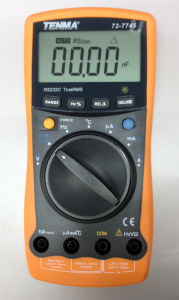A few weeks ago I received a Tenma 72-7745 multimeter and I have been using it since. When I opened the box I liked it right away. Small and light, with plenty of functions, Tenma 72-7745 is a digital multimeter perfectly fit for anybody’s lab. It measures DC voltage, true RMS voltage, DC and AC current, resistance, capacitance, diodes, frequency, duty cycle and temperature. It has features like auto ranging, relative measurements and hold. The multimeter is part of a family, 72-7735, 72-7740 and 72-7745. It has a RS-232 interface, so that one can use a computer to log measurements. Here are a few tests and notes I made for this review.
Display
The display has good contrast, especially when it is viewed at 45 degrees from the perpendicular axis. Unfortunately, that is the direction where most glare occurs from the overhead lighting. It has 4 large digits with a maximum display of 3999. Various indicators show the measurement function, units, auto range, relative measurement, low battery, and the RS-232 connection. RS-232 seems always on, so this is a negative since it will contribute to shortening the battery life.
The display backlight can be turned on by holding down the Hold button until 2 LEDs on each side of the display turn on. They do not provide a lot of light, but I guess it is good enough in low-light environment.
Voltage Measurements
Any instrument specification sheet shows the measurement accuracy for each function, or so it should if the manufacturer stands by the instrument performance. Tenma 72-7745 spec sheet fully describes the instrument capabilities. For DC voltage measurements, the accuracy is +/-(0.8% + 3) for measurements up to 400 mV. These numbers represent gain and offset. The offset accuracy is expressed in number of digits. I used a calibrated voltage source, Keithley 263, to test the DC voltage measurement. At 0 volts input, Tenma 72-7745 showed a perfect 0.0 mV on both auto range and fixed range. When tested at 1mV, 10mV, 100mV and 1V inputs, the multimeter showed 0.9 mV, 9.9 mV, 99.8 mV and 1.001 V respectively, well within specifications.
Tenma 72-7745 is the only one in this family that can measure true RMS values. In AC voltage mode, this multimeter can measure RMS values of signals with the frequency between 40 Hz to 400 Hz, and with very good accuracy. Testing 715 mV RMS sine wave at different frequencies, 10 Hz, 100 Hz and 1 kHz, Tenma 72-7745 showed 689 mV, 711 mV, and 703 mV respectively. 10 Hz and 1 kHz are a stretch, but I wanted to see how much I can push it and still measure AC voltage levels with good precision.
True RMS also means that the instrument should be able to measure different waveforms and display a value equivalent with the square-root of the average of the square of the signal (see MasteringElectronicsDesign.com: How to Derive the RMS Value of Pulse and Square Waveforms). To test the instrument capability I measured the RMS value of different waveforms with 1 V amplitude at 200 Hz frequency and compared the result with the one shown by the popular Tektronix scope TDS-3054. A 1V amplitude 200 Hz triangle waveform RMS value measured by Tenma 72-7745 was 0.581V, while Tektronix TDS-3054 showed 0.584V. A ramp RMS value measured by Tenma 72-7745 was 0.573V, while TDS-3054 showed 0.584V. A square wave RMS value was 0.994V as measured by Tenma 72-7745, while TDS-3054 showed 1.00V. All 3 signal values comply with the theoretical calculation of the RMS value for these waveforms. See MasteringElectronicsDesign.com: How to Derive the RMS Value of a Triangle Waveform and other RMS articles in this website. .
Current Measurements
For current measurements Tenma 72-7745 uses two scales, a milliamp scale up to 400 mA and an amp scale up to 10 A. Both ranges are fused and have separate fuses to protect the input circuitry against overdrive.
I used the same Keithley 263 in current mode to test the multimeter current measurements. Again, I tested the multimeter behavior with no current at its input. It showed 0.0uA, no offset. I also tested it at 1 uA, 10 uA, 100 uA, 1 mA and 10 mA. Tenma 72-7745 measured 0.9 uA, 9.9 uA, 99.8 uA, 1001 uA and 9.99 mA respectively, which are within the instrument precision. The amp scale follows the same precision, although the measurements should be done fast, in less than 10 seconds, so that the internal calibrated components do not warm up and start adding errors to measurements. The manufacturer also recommends a wait time of 15 minutes between measurements on the amp scale, to let the circuitry cool down.
Resistance Measurements
Like any respectable multimeter, Tenma 72-7745 can measure resistors up to 40 Mohms in 6 ranges, 400 ohms, 4 kohms, 40 kohms, 400 kohms, 4 Mohms, 40 Mohms. I like that the multimeter resolution is 0.1 ohms on the lowest range of 400 ohms. Making a short circuit between inputs, the multimeter showed a solid 0.0 ohms, which is impressive since other multimeters in this class have bouncing numbers around the resolution value. I have a few calibrated resistors that I used to test the multimeter. A 4.678 ohm resistor was measured 4.8 ohms with short probes, a very good result taking into consideration that the resolution is 0.1 ohms. Moving away from the instrument resolution, with a resistor of 26.765 ohms, I measured 26.6 ohms, well within the accuracy specification of +/-(1.2% + 5).
(Continued on next page…)






It’s very nice tool.It’s easy to read display with backlight. This unit has many features I did not expect.